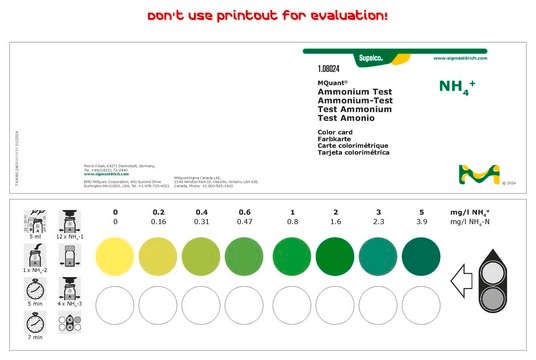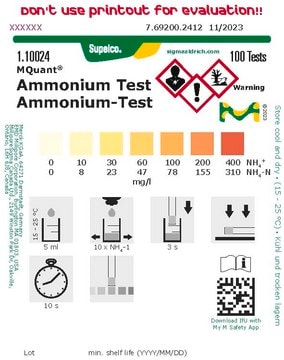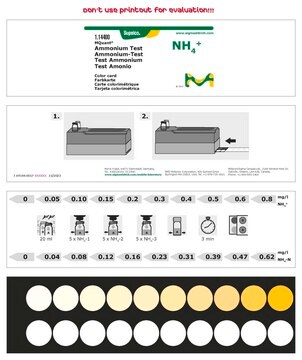MAK310
Ammonia Assay Kit
sufficient for 200 fluorometric tests
Synonim(y):
Ammonia Quantitative Test Kit
Zaloguj sięWyświetlanie cen organizacyjnych i kontraktowych
About This Item
Kod UNSPSC:
12161503
NACRES:
NA.84
Polecane produkty
metoda wykrywania
fluorometric
powiązane choroby
genitourinary disorders; gastrointestinal diseases
temp. przechowywania
−20°C
Opis ogólny
Ammonia (NH3) or the ammonium ion (NH4 +) is found in the atmosphere, rainwater, soil, seawater, and volcanic areas. It is widely used as fertilizer, being an important source of nitrogen for living systems. It also plays a role in animal physiology. Ammonia is produced by amino acid metabolism and is converted to urea in the human liver through the urea cycle. Ammonia acts as a precursor for various other nitrogen compounds. It is a colorless gas with pungent odor and can be easily liquefied. It is also used as a feed supplement in livestock industry.
Cechy i korzyści
Compatible with high-throughput handling systems.
Przydatność
Suitable for the quantitative determination of ammonia/ammonium concentration in biological samples, such as urine, and environmental samples
Zasada
The Ammonia Assay Kit provides a simple and high throughput adaptable assay for quantitative determination of ammonia/ammonium ion concentration in biological samples, such as urine, and environmental samples. This assay is based on the o-phthalaldehyde method in which the reagent reacts with ammonia/ammonium ion producing a fluorometric result ( ex = 360/ em = 450 nm), proportional to the ammonia concentration in the sample. The kit has a linear detection range of 0.012–1 mM ammonia in a 96 well format.
This page may contain text that has been machine translated.
Hasło ostrzegawcze
Danger
Zwroty wskazujące rodzaj zagrożenia
Zwroty wskazujące środki ostrożności
Klasyfikacja zagrożeń
Acute Tox. 4 Oral - Aquatic Acute 1 - Aquatic Chronic 1 - Eye Dam. 1 - Skin Corr. 1B - Skin Sens. 1
Kod klasy składowania
8A - Combustible corrosive hazardous materials
Temperatura zapłonu (°F)
188.6 °F
Temperatura zapłonu (°C)
87 °C
Certyfikaty analizy (CoA)
Poszukaj Certyfikaty analizy (CoA), wpisując numer partii/serii produktów. Numery serii i partii można znaleźć na etykiecie produktu po słowach „seria” lub „partia”.
Masz już ten produkt?
Dokumenty związane z niedawno zakupionymi produktami zostały zamieszczone w Bibliotece dokumentów.
Klienci oglądali również te produkty
Hazardous materials chemistry for emergency responders, 553-553 (2013)
Beatriz Vallejo et al.
Microbial cell factories, 19(1), 124-124 (2020-06-09)
Saccharomyces cerevisiae wine strains can develop stuck or sluggish fermentations when nutrients are scarce or suboptimal. Nutrient sensing and signaling pathways, such as PKA, TORC1 and Snf1, work coordinately to adapt growth and metabolism to the amount and balance of
Umarah Mubeen et al.
The Plant cell, 30(10), 2240-2254 (2018-09-20)
The Target of Rapamycin (TOR) kinase is a central regulator of growth and metabolism in all eukaryotic organisms, including animals, fungi, and plants. Even though the inputs and outputs of TOR signaling are well characterized for animals and fungi, our
Daphné Coache et al.
PloS one, 17(6), e0270206-e0270206 (2022-06-25)
This study assessed the stability of six extemporaneously compounded hydroxyurea oral liquids stored at room temperature. Hydroxyurea oral liquids (100 mg/mL) were prepared using three different mixing methods (mortar, mixer or QuartetRx) from either bulk powder, capsule content, or whole
Adam Armada-Moreira et al.
Advanced biosystems, 4(10), e2000139-e2000139 (2020-09-02)
Excitotoxicity is a cellular phenomenon that comprises the consequences of toxic actions of excitatory neurotransmitters, such as glutamate. This process is usually related to overproduction of reactive oxygen species (ROS) and ammonia (NH4+ ) toxicity. Platinum nanoparticle (Pt-NP)-based microreactors able
Nasz zespół naukowców ma doświadczenie we wszystkich obszarach badań, w tym w naukach przyrodniczych, materiałoznawstwie, syntezie chemicznej, chromatografii, analityce i wielu innych dziedzinach.
Skontaktuj się z zespołem ds. pomocy technicznej












